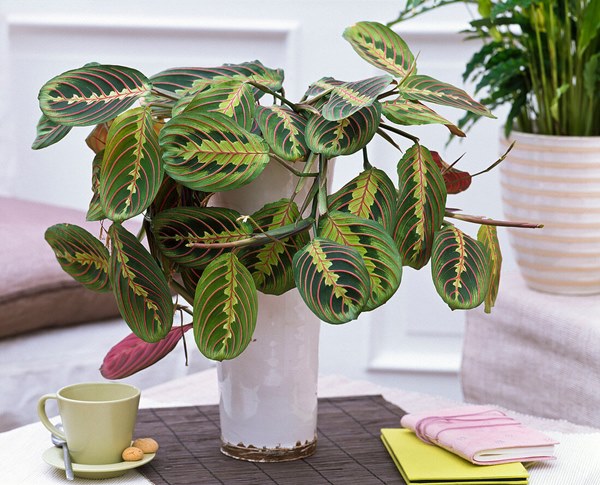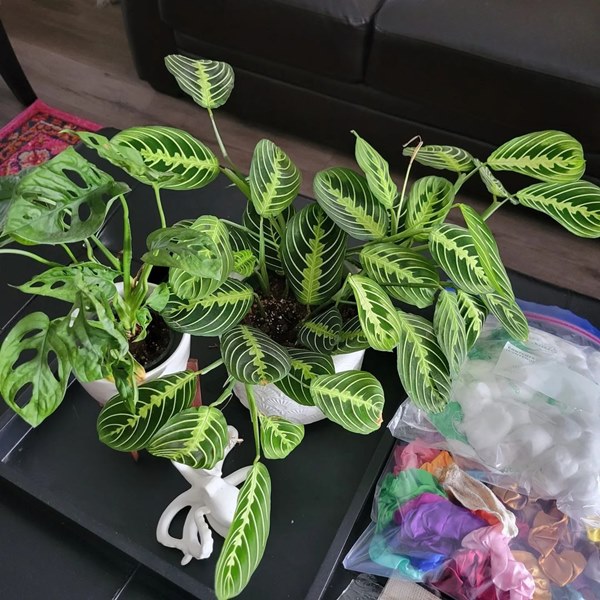Prayer Plant Care Indoors | Grow Prayer Plant
Growing Prayer plants indoors is easy and fun. Here is all you need to know about Prayer Plant Care Indoors.
Don’t forget to Check out these Prayer Plant Benefits!

Botanical Name: Maranta leuconeura
Prayer plant is a unique houseplant with foliage that opens and folds as if in prayer to god. This bizarre nature of the Prayer plant makes it stand out among other houseplants. Growing prayer plant indoors is not difficult as it’s a hardy, resilient houseplant. Learn about prayer plant care indoors and propagation in this post!
How to Grow Prayer Plant Indoors

Prayer plants prefer bright indirect light and won’t tolerate direct light. Furthermore, they are adaptable to low-light conditions and can grow in dark areas of the home. Shallow pots are a must to prevent waterlogging as they have a shallow root system. Don’t allow the soil to dry out completely by watering regularly. Hanging baskets are also a good choice for prayer plants!
Prayer Plant Propagation
Division is the easiest and most successful way to propagate the prayer plant. Apart from that, you can also propagate Prayer plants from stem cuttings. Here is how to do it!
- While repotting prayer, plants divide the root clumps to give rise to individual plants.
- Gently shake off the soil sticking to the roots making sure not to cause any damage.
- Separate the clump so that each clump has a substantial root mass and stems attached.
- Fill the pot with a well-draining potting mix and plant prayer plant.
- Locate the pot in a warm spot and keep the potting mix moist.
- Soon you’ll see new growth emerge!
Take a cutting just below the leaf node to propagate the prayer plant from stem cutting. Plant the cutting in a well-draining potting medium that contains peat moss and perlite. Keep the pot in a warm spot and cover it with a plastic sheet for a greenhouse-like effect. Don’t forget to make some holes in the covering for air circulation. Place the pot in a warm spot and water regularly to keep the mix moist. You’ll ne be rewarded with new growth from a few weeks to a month!
Choosing the Container
Go for a more shallow and wide pot, as prayer plants have a shallow root system. Ensure the pot has drainage holes at the bottom; if not, drill some. You can choose plastic, terracotta, or any other material that suits your needs.
Repotting
Repot prayer plant when it becomes root bound to give roots more room to grow. Rooting growing out from the bottom of the pot and little to no growth is some signs of a root-bound plant. Choose a pot couple of sizes large than the current pot. The ideal time for repotting is in spring or summer.
Location
Prayer plants tolerate low-light conditions and do well in bright, indirect light. Keep it away from windows without drapes, as direct sunlight can scorch the leaves. It makes an excellent centerpiece plant for tabletops and office desks.
Soil
Prayer plant isn’t fussy about potting medium; any basic houseplant potting mix that’s well-draining will do well. Add perlite and peat moss (coco coir) to the mix to improve drainage if it isn’t well-draining. Slightly acidic soil with a pH ranging from 6 to 6.5 is what prayer plant favors.
Watering
Water regularly and never allow the soil to dry out completely. Although to prevent overwatering, check that the soil is dry a couple of inches below the surface before you water. Also, water at the base and not over the foliage. Cut back watering in winter as the prayer plant becomes dormant in winter.
Temperature and Humidity
Prolonged exposure to temperatures below 50 degrees F adversely affects the prayer plant. The ideal temperature range for a prayer plant lies between 65 to 82 degrees F. It loves high humidity, so mist around the plant, place it near a humidifier, or put a pebble tray filled with water near it to raise humidity levels.
Prayer Plant Care

Pruning
The prayer plant does not require pruning, but you can still snip it off from the top. Cut back from above the leaf nodes at the top to encourage side growth. It’ll make the prayer plant bushier and fuller.
Fertilizer
Use a well-balanced liquid fertilizer from late spring to early fall twice a month. Avoid too much fertilization, which leads to browning leaves and can even kill the prayer plant. In winter, reduce fertilization to once a month.
Pests and Diseases
Common garden pests such as aphids, mites, and mealybugs can cause some level of damage to the foliage. Organic pesticides such as neem oil will eliminate these pests in no time. If you have been the culprit of overwatering in the past, it leads to root rot. So always check the soil before watering!
Prayer Plant Toxicity
We have good news for you on this front! Prayer plant is non-toxic for pets and children, as per ASPCA. So you can keep the player plant indoors without any worry.




